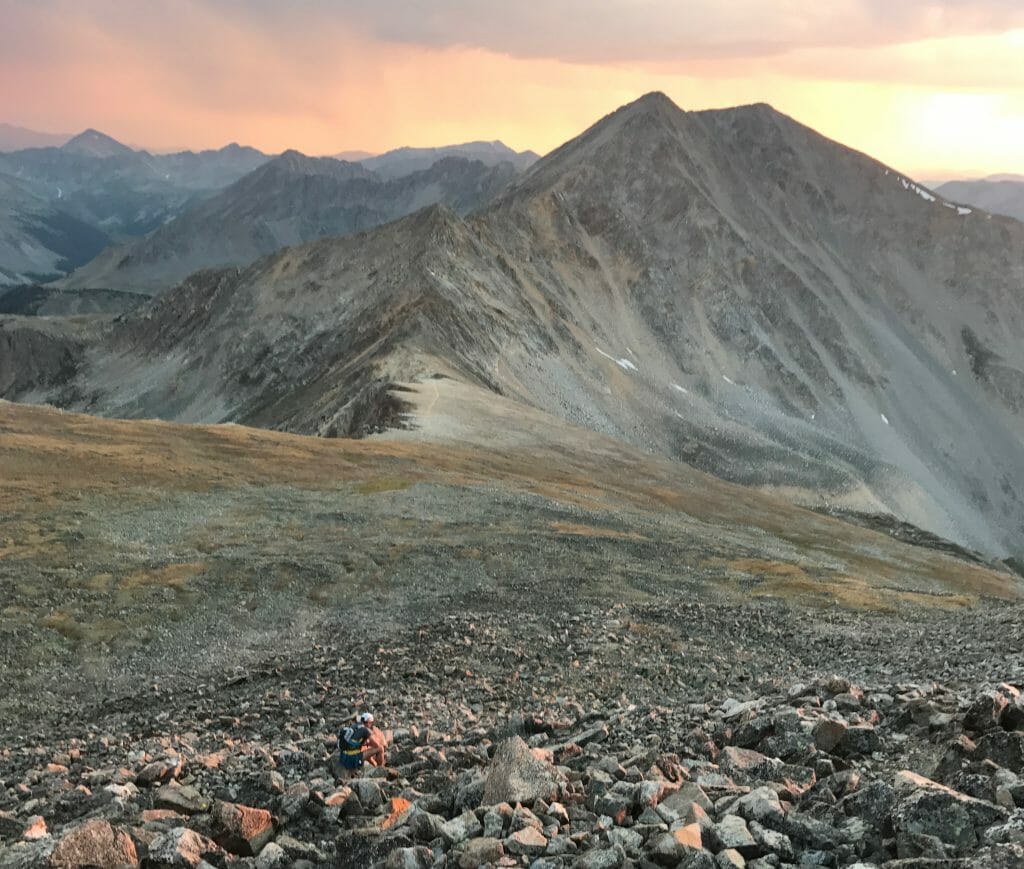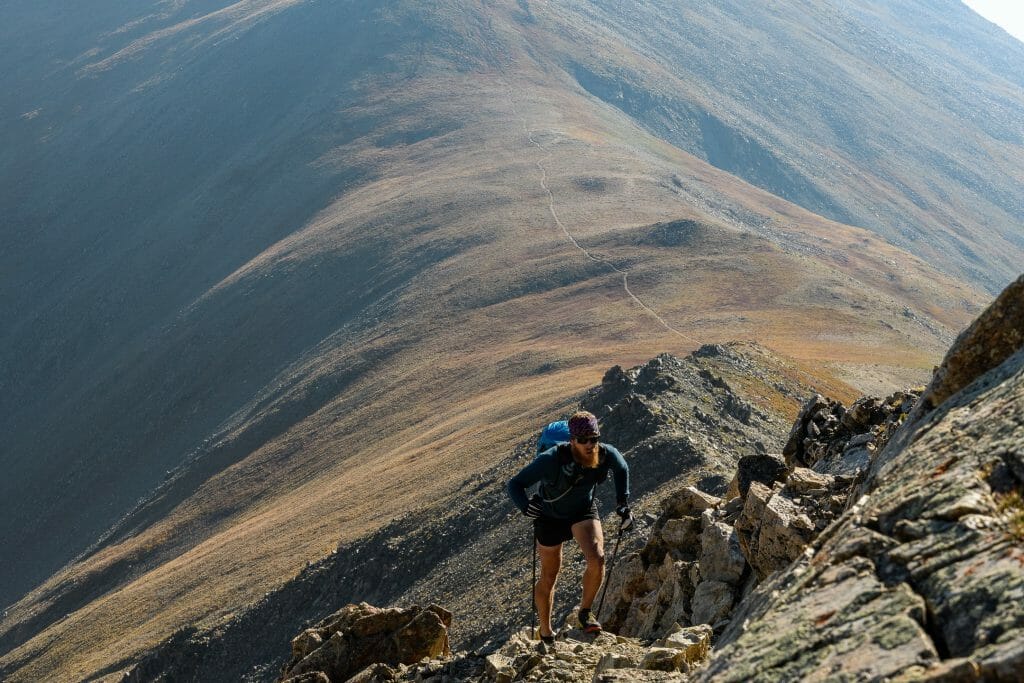The voices had gotten progressively louder, yet continued to be muffled. It sounded like being in a very crowded restaurant with dozens of conversations happening, but none clear enough to understand. The strange thing is that I wasn’t in a restaurant. I was just below 14,000 feet, descending a loose, steep ridgeline off of Mount Elbert in Colorado.
Nearly a day and a half earlier, Jared Campbell and I had left the Blank Cabin Trailhead. Together, we hoped to complete the Nolan’s 14, and wanted to do it as fast as possible. Nolan’s is an incredible challenge. In order to complete it, you have to summit 14 14,000-foot peaks in the Sawatch range in Colorado. You can pick and navigate your own route. There are no course markings, and you have to summit the final peak in less than 60 hours to be an officially recognized finisher. The odds of finishing are terribly low, somewhere around 15 percent. The combination of distance (nearly a hundred miles), vertical gain and loss (46,000 feet of each), and the overall high-altitude travel all combine to form a very high level of difficulty. Throw in the variable of mountain weather, and it is clear the odds are against anyone bold enough to attempt it.
Jared was no stranger to the route. He was the fifth or sixth person to complete the challenge when he and Matt Hart finished in 2012. He had also been on the route just a month previous to our attempt, when he and Gary Robbins had a full epic with terrible weather and still managed to finish despite a 6-hour detour when they took a break due to dangerous hypothermia-inducing conditions. Once they warmed up, they reevaluated and decided to head back out onto what I consider one of the most incredible feats of mental fortitude ever.
I had not climbed one peak on the route. I had spent weeks poring over maps, satellite imagery, and previous trip reports in an attempt to understand the terrain and the route. Despite my thorough electronic preparation, I was not mentally prepared for what lay ahead.
To be completely honest, the route is so huge that a lot of the details are fuzzy in my brain. We moved well up the first several peaks, full of optimism and fresh legs. I think it was the ascent up Princeton where doubt started to creep in. Both Jared and I were moving well, but we were around 11 hours in and just nearing the summit of the fourth peak. I started to unravel just a little at the immensity of what lay ahead. Consistent forward progress was the name of the game for the next 12 hours. Through the night we managed to hold things together pretty well, with the exception of some excessive sleepiness that we dealt with on the summit of Harvard by taking a brief 10-minute nap.
Typically in ultras, the dawn brings renewed hope and energy. I guess this wasn’t any different; we had increased mental clarity and sleepiness faded to the background. There was one major difference for me. I started to consider what remained. We were working our way up Oxford peak, Jared and I both digging in to the hurt locker a little as we clawed up the seemingly endless shoulder of the peak. There was a rift forming in my brain between what was done and what remained. It was an incredibly overwhelming feeling of incomprehension. Over 24 hours in and we were not even halfway. At the summit I realized that I could not even imagine what it would take to cover the remaining 50-plus miles and six peaks, the three final being some of the most challenging.
An hour later, on the summit of Belford, I buried the building sense of panic and determined to just harden up and get it done. It worked for a time, maybe even to the summit of Missouri, but when Jared pointed out the next peak, Huron, the panic returned. The rift that had been forming exploded in my brain and I decided that it was too much. I felt there was too much distance, too much ascending, just too much for me to understand how to proceed. At this point I gave up mentally. Fortunately, it was too challenging to simply bail at that point. As we descended Missouri I explained my broken state to Jared. It felt a little silly to tell the man who had finished the same route a month earlier in terrible conditions that I couldn’t even imagine how to endure.
Jared listened carefully and spoke little as I tried to justify not continuing. He did say two things, though, the first being: “This is what you signed up for.” That comment penetrated through the defeated thoughts I was having and resonated. It was completely true. I knew before we started that this would be the hardest thing I had ever done and how silly of me to think that I could really understand what that meant until I was in the thick of it. The second thing Jared said was a small request. He asked that I not pull the plug until after spending 30 minutes with our crew. I agreed to give it some time and then hunkered down in my own brain surrounded by thoughts of negativity and failure.
It would be a quiet ascent of Huron. In a strange twist of fate a dry spring actually helped me to get through that peak not completely focused on quitting. We did not fill our water near Clohesy Lake, and opted for a spring about a third of the way up the ascent. It was dry when we arrived and so were our packs. I had to focus my efforts in trying to locate some water, or at least ration the 250 milliliters in my soft flask. The heat of the afternoon was amplified by our progressive dehydration, but it got me out of my own head a little. Just after summiting, we crossed paths with a friend who shared water with us, tiding us over for the descent to water. With the dehydration crisis averted, I slipped back in to my downward spiral of negativity. By the time we were shuffling down the road to Winfield, I was again determined to quit. I told Jared it was a 5 percent or less chance of my carrying on.
As we came into Winfield we crossed paths with the crews of several other runners who were attempting Nolan’s as well. Seeing the other crews had an odd effect on me, shattering the negativity as I thought of the optimism all who attempt Nolan’s set out with. I thought of all the work and sacrifice that had gone into preparing for this adventure as we covered the last half mile to our crew.
As we walked into the crew site, I saw John Sharp. The last time I had seen him was when we passed him on the summit of Tabeguache. I am not sure where he had abandoned his attempt, but he was here offering his support to us. This had a very profound impact on me. Jared and I only had three peaks remaining, and we hadn’t quite been out 36 hours. Mentally I was a wreck, but physically not as bad. I guess I felt as good as could be expected after a day and a half of moving at elevation in the mountains. It immediately became clear that it didn’t matter if I could wrap my head around what remained, it just mattered that I keep moving. In less than 5 minutes with our crew, I told Jared that I did want to continue despite the grim picture I had tried to paint earlier. We shifted our action plan and after refueling and a short rest we headed back out.
It is strange to me that I never again doubted whether I would be able to finish. With a renewed sense of purpose, and probably the bump from eating nearly 2,000 calories with our crew, I plodded up La Plata. On the ridge the sun set and gifted us one of the most amazing sunsets I have experienced. As darkness settled, the immensity of what we had done became manifest physically. Both of our stomachs started getting finicky, and it was challenging to keep the calories flowing. In Winfield, John had recommended that I use a soft flask for mashed potatoes since they had gone down so well there, and it was a huge hit for me for the grind up and over La Plata.
Elbert, the second-to-last peak and the highest in Colorado, dished out a special kind of challenge as we spent over an hour right near 14,000 feet working our way over Bull Hill toward the summit. Jared’s stomach had a full-on rebellion in that section and he may have awakened the folks in Leadville with one of the most impressive bouts of puking I’ve witnessed. Despite the nausea he charged ahead, never once complaining about feeling terrible. Just after the summit of Elbert I started to hear the voices. Quiet at first, like a room full of whispers, but building to the point that I asked Jared if he was hearing them. He was not. It was weird. I knew that I was having auditory hallucinations but the line between reality and hallucination started to dissolve.
The dawn arrived at the same time we met our crew once again. There was a brief battle between my stomach and a banana that resulted in the rapid expulsion of said banana. The battle swung the other way after a couple of bites of a quesadilla and Mexi-Coke that stayed aboard as we left en route to the final peak, Mount Massive. I guess it was at this point that I was finally able to visualize completing the remaining miles, and it offered a strange source of energy. I was not eating well or much of anything, but despite such a minimal caloric consumption I was able to plow forward. The length and difficulty of Nolan’s had incrementally stripped away ego and emotion and as we pulled onto the summit block after 51 hours and 29 minutes, I wept. I am not sure why the emotion that boiled over was accompanied by tears, but I think they were of joy. Jared pulled into the lead and set an honest pace for the final descent to the Fish Hatchery, and it was then that I felt the physical toll in my legs, arms, and pretty much the rest of my body.
As we cruised the last mile or so, side by side on the wide trail, we didn’t say much. Jared and I have been adventure partners a long time, and conversation took extra effort, but I couldn’t help but think of the sage advice Jared had given me when I was mentally bottomed out. “This is what you signed up for.” And it was. I signed up to do something terribly difficult, that would challenge me physically and mentally to nearly or maybe right to my breaking point. I had chosen to do it with one of my best friends, and now side by side minutes away from completing this incredible challenge, I signed up to celebrate a deep friendship, the type that can only be forged by moving through the mountains.
You May Also Be Interested In:
- All of Utah’s 13,000-foot Peaks—Nonstop in 33 Hours
- Six Tips for Mountain Runners
- Confronting the Impossible at the Tor des Geants
- Why Miles Matter in Running


